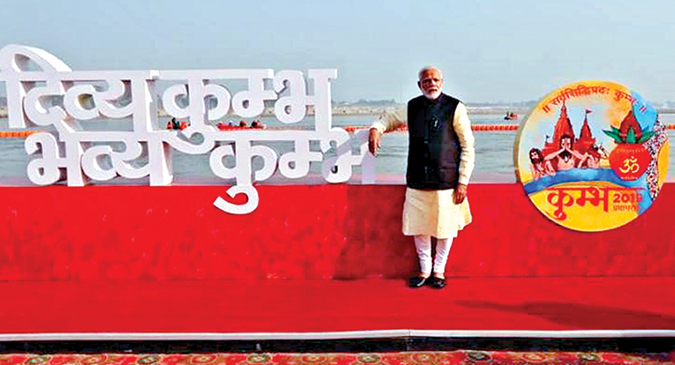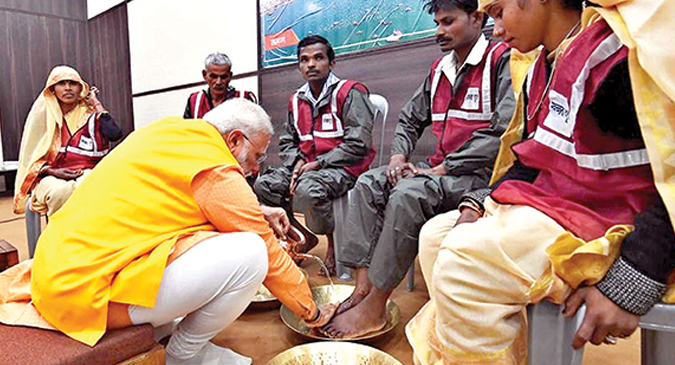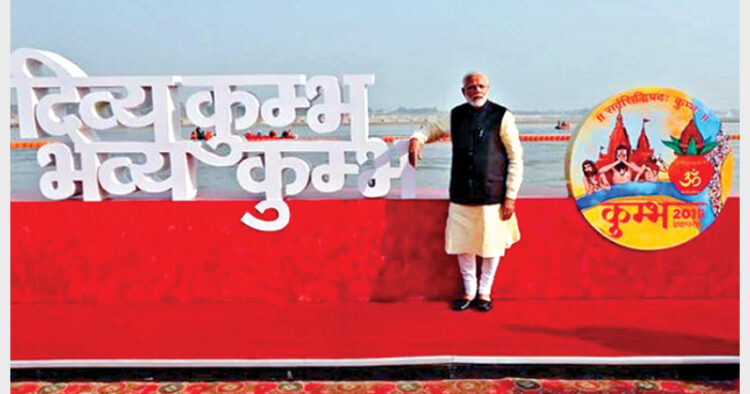Bharat, the world’s most populous nation, has proved how to run the world’s most ambitious Swacch Bharat campaign through efficient handling of sanitation and waste disposal programme on an unprecedented scale
Ashok B Sharma
Bharat has proved to the world that it can manage sanitation and waste disposal programme on a large scale. The test for this was in large traffic and crowd management plan and cleanliness drive at the recently-concluded Kumbh Mela, the largest conclave of religious gathering, at Prayagraj, Uttar Pradesh.

The Kumbh Mela showed the way to cleanliness through the huge success of Swacch Bharat
Kumbh Mela attracted millions of pilgrims from across the country and abroad, including devotees, sadhus (holy men) from various sects of Hinduism and hundreds and thousands of visitors.
Designated as “Intangible Cultural Heritage of Humanity” by UNESCO during its 12th session held at Jeju in South Korea in December 2017, Kumbh 2019 could soon prove its worth by entering Guinness World Records for three specific reasons – the largest crowd management, largest sanitation drive and largest painting exercise at public sites.
The 49-day-long religious festival on earth at Prayagraj began on January 15 (the day of solar ingress in Capricorn sign) formally concluded on March 4, the holy day of Shivaratri.

PM Modi washing the feet of the scavengers during the Prayagraj Kumbh
A three-member team from the Guinness World Records visited Prayagraj for the purpose. Exercises at a large scale were performed before the team for four days, from February 28 to March 3.
“Around 503 shuttle buses were pressed into service on the highway in one go for the team on February 28. Several people participated in a painting exercise on March 1 and 10,000 sanitation workers engaged in cleaning at the Kumbh, all performing their duties together,” the Ministry of Culture said in a statement.
The host state of Uttar Pradesh successfully set a record for the “Longest Parade of Buses” lining up 500 buses in a row for nearly two miles. It also set a new record for “most contribution in hand painting in 8 hours.”
Prayagraj is situated at the confluence of rivers Ganga, Yamuna and the mythical Saraswati. A dip in the river at Kumbh Mela is considered sacred by the people of Hindu faith.
Maha Kumbh Mela is held every 12 years. Such Maha Kumbh Mela was held in 2013 at Prayagraj. However, at the interval of six years, Ardha Kumbha melas are held at designated places as per planetary positions. Kumbh 2019 is Ardha Kumbh mela.
The ageless tradition of Kumbh finds mentions in the writings of the ancient Chinese traveller Hsuan Tsang. Earlier, the management of the Kumbh mela was in the hands of Akharas or different sects of sadhus who oversaw the collection of taxes, policing and judicial duties. However the management was taken over by the British colonial rulers in 1870 after the occurrence of stampede and chaos. Since then the management of the Kumbh has been with the Government.
Among the various religious practices, the principal one is the holy dip or Maha Snan (Great Bath). During Mughal rule a royal decree was issued for establishing the order of precedence in bathing during auspicious period at the confluence of rivers. Thus the holy dip or Maha Snan came to be known as Shahi Snan (Royal Bath).
Following Shahi Snans took place this year–Makar Sankranti (January 15), Paush Poornima – Full Moon day of the lunar moth Paush (January 21), Mauni Amavasya – New Moon day (February 4), Basant Panchami (February 10), Maghi Poornima (February 19) and Maha Shivratri (March 4).
In this year’s Kumbh an estimated 240 million people took a holy dip in the confluence of rivers as compared to 120 million in the Maha Kumbh of 2013.
India’s iconic Kumbh in 2019 has many firsts associated with it, such as the inauguration by Prime Minister Narendra Modi with Ganga Aarti, visit of VIPs including President of India, ambassadors of 70 countries, citizen from 193 countries and opening up of Saraswati Koop and Akshay Vat for public view after 450 years.
The host state Uttar Pradesh had made excellent arrangements for sanitation by putting in place 1,22,000 toilets and 20,000 dustbins besides deploying 140 tippers and 40 compactors for ensuring solid waste management. About 1000 sanitation workers were pressed into service along with 12,000 security personnel on duty to maintain law and order.
A fool-proof arrangement was made for the first time, under which garbage was lifted from dustbins and toilets through latest technique preventing it from scattering on the ground, collecting it in a compactor by Tata S vehicles and taking it out of the mela (fair) area for proper disposal and processing. The work of sewer connection and setting up of pumping station by laying 177 km sewer lines was completed.
To keep the river water clean in the mela area, 32 drains opening in the river Ganga have been sealed and four schemes are being implemented in Prayagraj under Namami Gange Programme. Arrangements were made to treat river water through bio-remediation so that no effluent pollutes the rivers in Prayagraj. With a view to ensuring proper crowd management, the Uttar Pradesh state government had constructed new flyovers in the city, over bridges, expanded roads and brightened the mela area by installing over 40,000 LED lights and about 1400 CCTV camera integrated to a central command and control system. The conception of linking Prayagraj with all the three routes – air, road and waterways – was fully realised. The Inland Waterways Authority set up five jetties, facilitating operation of large cruises and motor boats. A new air civil terminal was constructed in Prayagraj. A number to tent cities and food courts were set up for comfortable stay.
Thus the iconic Kumbh has set an example of large scale sanitation drive and large crowd management.
(The writer is a New Delhi-based columnist on strategic and policy)














Comments